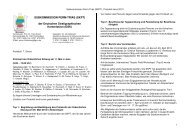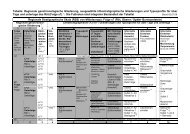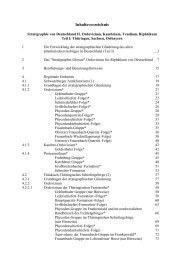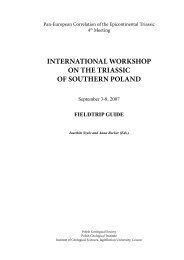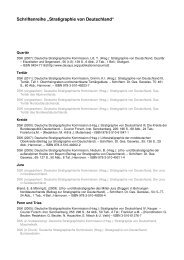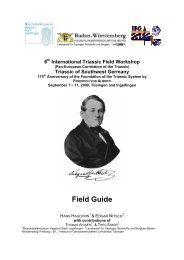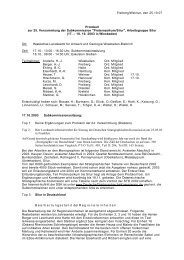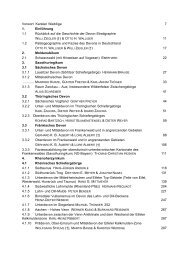International Field Workshop on 'The Triassic of eastern France'
International Field Workshop on 'The Triassic of eastern France'
International Field Workshop on 'The Triassic of eastern France'
Create successful ePaper yourself
Turn your PDF publications into a flip-book with our unique Google optimized e-Paper software.
Silurian and Proterozoic graphitic cherts that are derived from the Armorican Massif (Durand et al., 1994;<br />
Dabard, 2000), implying same provenance. The transiti<strong>on</strong> between the ‘Grès vosgiens’ and the ‘C<strong>on</strong>glomérat<br />
principal’ reflects <strong>on</strong>ly a progressive increasing in gravel c<strong>on</strong>tent and then an accelerati<strong>on</strong> <strong>of</strong> the prograding<br />
phase. The base <strong>of</strong> the ‘C<strong>on</strong>glomérat principal’ is diachr<strong>on</strong>ous: c<strong>on</strong>glomeratic facies are younger in the<br />
western part <strong>of</strong> the basin (Cycle B4, Fig. II.4).<br />
Geometrically, the correlati<strong>on</strong>s (Fig. II.3 and II.4) reveal the landward migrati<strong>on</strong> <strong>of</strong> the silty-clay<br />
facies (attributed to playa deposits <strong>of</strong> the Karlstal Formati<strong>on</strong>) into a retrogradati<strong>on</strong> trend, until the maximum<br />
flooding surface <strong>of</strong> the cycle B3, and then a progradati<strong>on</strong>al trend <strong>of</strong> sandst<strong>on</strong>e and c<strong>on</strong>glomerate deposits <strong>of</strong><br />
the ‘C<strong>on</strong>glomérat principal’ Formati<strong>on</strong>. This evoluti<strong>on</strong> characterizes a major cycle, where the period <strong>of</strong> the<br />
stratigraphic base-level rise is represented by the cycle B1 to B3 and the period <strong>of</strong> the stratigraphic base-level<br />
fall by the cycle B4 (Figs. II.3 and II.4). This cycle is located above the Permian and below the Anisian, thus<br />
it is called the Scythian cycle.<br />
The top <strong>of</strong> cycle B4 is marked by a major disc<strong>on</strong>tinuity, above a sedimentary break. This episode can<br />
be correlated with the forming <strong>of</strong> the ‘Z<strong>on</strong>e Limite Violette’ that crops out in many parts <strong>of</strong> Lorraine (Fig.<br />
II.2). The ‘Z<strong>on</strong>e Limite Violette’ overlies the ‘C<strong>on</strong>glomérat principal’ Formati<strong>on</strong> and c<strong>on</strong>tains paleosols<br />
(dolocretes and silcretes), providing evidence for very low sedimentati<strong>on</strong> rates (Durand and Meyer, 1982). In<br />
north Lorraine, the ‘Z<strong>on</strong>e Limite Violette’ and even the ‘C<strong>on</strong>glomérat principal’ are locally eroded. This is<br />
indicated locally by the occurrence <strong>of</strong> a c<strong>on</strong>glomerate c<strong>on</strong>taining ‘C<strong>on</strong>glomérat principal’ pebbles mixed<br />
with pedogenic carb<strong>on</strong>ate and cornelian pebbles reworked from the ‘Z<strong>on</strong>e Limite Violette’. This unit, known<br />
as ‘Karneolk<strong>on</strong>glomerat’ in the Palatinate (Reis and v<strong>on</strong> Amm<strong>on</strong>, 1903), corresp<strong>on</strong>ds to the ‘C<strong>on</strong>glomérat de<br />
Bitche’ defined in northern Lorraine (Ménillet et al., 1989). In additi<strong>on</strong>, well-log data allow to recognize<br />
locally c<strong>on</strong>glomerate facies above the disc<strong>on</strong>tinuity (e.g. Saulcy and Johansweiller, Fig. II.2, II.4). The<br />
erosi<strong>on</strong>al surface corresp<strong>on</strong>ds to the ‘Hardegsen unc<strong>on</strong>formity’ expressed in many parts <strong>of</strong> the Germanic<br />
basin (Durand et al., 1994).<br />
II.2.2. Upper Buntsandstein cycles<br />
The lithostratigraphic successi<strong>on</strong> comprising the Upper Buntsandstein formati<strong>on</strong>s (‘Couches<br />
intermédiaires’ and ‘Grès à Voltzia’) the Lower Muschelkalk (‘Grès coquillier’, ‘Complexe de Volmunster’,<br />
and ‘Dolomie à Myophoria orbicularis’), and the lower part <strong>of</strong> the Middle Muschelkalk (‘Couches rouges’<br />
Formati<strong>on</strong>) corresp<strong>on</strong>ds to three minor cycles (noted B5 to B7, Fig. II.2). They bel<strong>on</strong>g to the lower part <strong>of</strong><br />
the major Anisian-Carnian cycle.<br />
The sandst<strong>on</strong>e facies <strong>of</strong> the Upper Buntsandstein corresp<strong>on</strong>d to low sinuosity fluvial channels<br />
(Durand, 1978; Durand et al., 1994). The well-log data allow a quantificati<strong>on</strong> <strong>of</strong> sandst<strong>on</strong>es, floodplain<br />
and/or lake deposits and sabkha lith<strong>of</strong>acies and the expressi<strong>on</strong> <strong>of</strong> the genetic units in these depositi<strong>on</strong>al<br />
envir<strong>on</strong>ments.<br />
The well-log analyses allow to characterize the occurrence <strong>of</strong> a new depositi<strong>on</strong>al area in the western<br />
part <strong>of</strong> the Paris Basin (Figs. II.3 and II.4). Its sediments seem to be c<strong>on</strong>temporaneous with those located<br />
above the disc<strong>on</strong>tinuity in the <strong>eastern</strong> part <strong>of</strong> the basin, where the three cycles can be correlated.<br />
17



